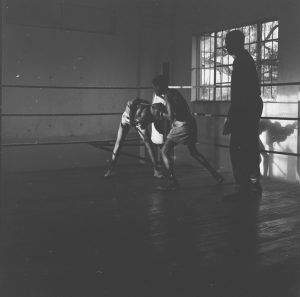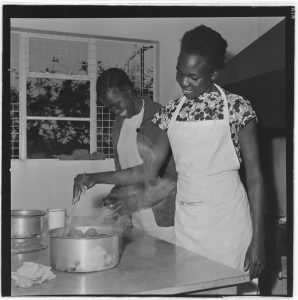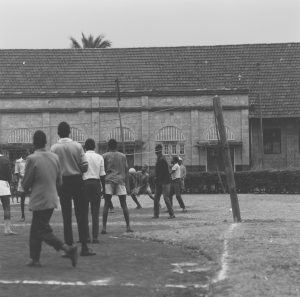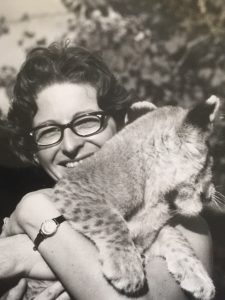Rolling with the punches
Posted on by Fay Curtis.
By Laura Dow, Volunteer Cataloguer and Nicky Sugar, Archivist
Laura and Nicky describe the range of emotions stirred by the Dorothy Myers photographs in the British Empire & Commonwealth Collection.
Laura

Boxing class in a Nairobi community centre (BECC 2019/004/1/18/8)
Two boys take part in a boxing lesson with their coach watching closely. One throws a jab towards his opponent, who raises his gloves over his head in defence.
The boxing ring is lit by a window. The light spills into the room and illuminates the boys, also obscuring our view of the coach, who is silhouetted.
There is a pleasing visual duality in this image: there is a stillness in the way the room is lit, yet it is also very active in the dynamic way that the three figures are interacting.
The photographer, Dorothy Myers, was a town planner in Nairobi during the 1960s and 70s.
These images, taken in the course of her work, depict scenes of daily life in post-colonial Kenya. They include industrial work in mills and factories, the building of social housing estates, and aerial shots of architecture around the city.

Cookery class in a Nairobi community centre (BECC 2019/004/1/19/9)
They also reveal the sites of the human interactions which are so crucial to building communities: schools, markets, football pitches – and especially community centre activities, including cookery and sewing sessions, board games and boxing classes.
Bristol Archives holds over 500 of Myers’ negatives in the British Empire & Commonwealth Collection. I have been helping to list these as a Volunteer Cataloguer.
The images provide valuable evidence of life during a pivotal moment in Kenya’s history, but they are also genuine. Myers is not an obtrusive presence and the scenes do not feel directed.
Because of this, it is easy for the viewer to imagine the scene beyond the frame, and the lives of the people portrayed. They seem to exude the optimism of a newly-independent nation.
I started cataloguing these images during the second lockdown, and finished the collection in the third. Working through these images, and seeing the closeness – both physical and in a wider concept of community – has been joyful, even a form of escapism.
Nicky

Volleyball game outside Kaloleni Social Hall (BECC 2019/004/1/15/2)
Last year, I was looking through the Dorothy Myers collection. In the background of a volleyball game, I recognised a building which appeared to be Kaloleni Social Hall.
Further research revealed that many of her photos of boxing and other activities were taken there. The hall itself is famous as the site of the first Kenyan parliament.
A highlight of my visit to Kenya in 2019 with the Building Shared Futures project was meeting Peter Kibue, a community leader from the Kaloleni Estate
Peter had a vision for how residents of Kaloleni and similar post-war estates could connect with each other around their heritage, if they had access to images like these. They could harness their shared history to stand up against development which is not always sensitive to their needs.
These pictures are recent enough that many of the people in them are still likely to be alive. I also knew from Peter that many current residents had lived their entire lives in the area.

Dorothy Myers with a lion cub, Kenya
My mind galloped ahead thinking of ways to make these images available. We could find out the stories of the boys who did boxing training and women who played barefoot football! Most importantly, the photos could help residents to connect with each other.
Sadly, as I turned to Google to check Peter’s email address, the first hits which came up were recent obituary notices for him.
The grief I felt seemed out of proportion to the short time I’d spent in his company. But his passing seemed to represent another door slamming shut between a post-colonial community and access to their heritage.
Thankfully we are still in close contact with the BSF team, and through their networks have identified other routes to connect with Kaloleni residents. We hope to explore these over the coming months.
We are very grateful to Laura for helping us make these images accessible and also to Dorothy and the rest of the Myers family for donating the collection and continuing to share their memories with us.